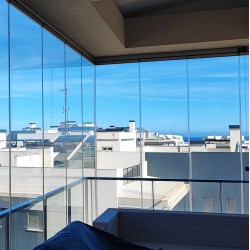Frameless and panoramic glazing are two different types of glazing that are used to create transparent surfaces in buildings.
Frameless glazing, as its name suggests, does not have frames around the panes that are commonly used to hold glass in a window opening. Instead, the glass is attached to the wall using special fasteners or hidden profiles, which creates the effect of "invisible" walls. Frameless glazing is often used in contemporary architecture to create clean lines and minimalist designs.
Panoramic glazing, unlike frameless, usually has frames around the glass. Such glazing is designed to maximize the use of space and create a wide view of the surrounding area. It can be made in various versions: from semi-panoramic with one horizontal or vertical line to full panoramic, occupying the entire wall.
In both cases, as a rule, special glasses are used, which have increased strength and thermal insulation properties, which allows maintaining a comfortable indoor temperature and reducing heating and air conditioning costs.
Folding doors: These are a type of glass doors that fold along the wall like a book. They are available in a variety of finishes, including clear, colored, matt or satin finishes, and can have a variety of decorative features.
Sliding Doors: These are a type of glass doors that slide along a wall or into another room. They are available in a variety of finishes, including clear, colored, matt or satin finishes, and can have a variety of decorative features.
Accordion Doors: This is a type of glass door that consists of several pieces that fold into an accordion shape. They are available in a variety of finishes, including clear, colored, matt or satin finishes, and can have a variety of decorative features.
Folding, sliding and accordion glass doors are used in various types of premises and building structures. Here are some examples where these types of doors can be used:
Indoors: Folding, sliding and accordion glass doors can be used to separate or unite interior spaces such as a living room, kitchen, bedroom, office or bathroom.
Balconies and Terraces: Folding and sliding glass doors can be used to create outdoor areas such as balconies or terraces.
Restaurants and cafes: Folding, sliding and accordion glass doors can be used in restaurants and cafes to separate catering areas or create open areas for visitors.
Offices and commercial spaces: Folding, sliding and bellows glass doors can be used in offices and commercial spaces to separate areas and create outdoor areas.
Detached houses and villas: Folding, sliding and accordion glass doors can be used in detached houses and villas to create open areas, provide light and space, and enhance decorative elements.
These are just some examples of the use of folding, sliding and accordion glass doors.
Some of the most common coatings and films used in panoramic windows are:
Glass tinting: This is the process of adding special dyes or pigments to glass to change its color. Tinted glass can be used to create the effect of transparency and different shades of light.
Mirror Coating: This is the process of applying a metallic layer to glass that reflects light and creates a mirror effect. Mirror coating can be used to create privacy or to create decorative elements in the interior.
Glass frosting: This is the process of creating a frosted surface on glass. Frosted glass can be used to create a private area or to create decorative elements.
UV Coating: This is the process of applying a layer to glass that protects it from UV rays. UV coating can be used to protect against the harmful effects of sunlight and to preserve the color and texture of materials behind glass.
Protective Film: This is a film that is applied to the glass surface to protect it from bumps, scratches, and other damage. Protective film can be used to protect against vandalism and other forms of glass damage.

















